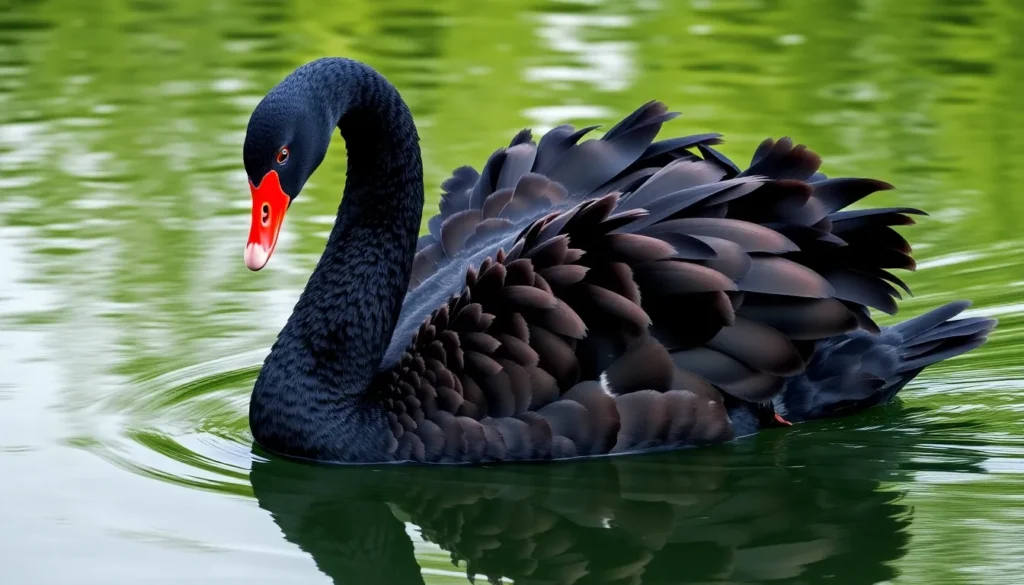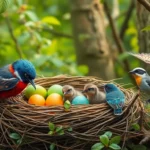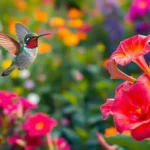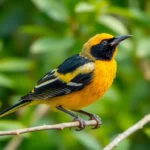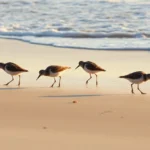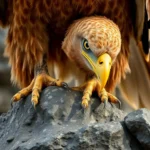We’ve all heard the phrase “black swan event” but few of us truly understand the magnificent bird that inspired this powerful metaphor. The black swan (Cygnus atratus) isn’t just a rare statistical occurrence – it’s a breathtaking waterfowl that’s captivated observers for centuries with its striking appearance and fascinating behaviors.
These elegant creatures challenge our preconceptions about swans while offering some of nature’s most compelling stories. From their unexpected discovery by European explorers to their complex social structures we’re only beginning to understand the black swan represents far more than its symbolic meaning suggests.
Whether you’re a bird enthusiast or simply curious about one of Australia’s most iconic species we’ll take you on a journey through the remarkable industry of black swans. You’ll discover why these birds have become symbols of the unexpected and learn about their unique adaptations that set them apart from their white cousins.
What Is the Black Swan Bird?
The black swan (Cygnus atratus) represents Australia’s iconic waterfowl species that defied European expectations when first discovered in 1697. We observe this remarkable bird as a living symbol of the unexpected in nature.
Physical Characteristics and Appearance
Black swans display predominantly jet-black plumage across their entire body with brilliant white flight feathers visible during wing displays. Their elongated necks feature the same deep black coloration that extends seamlessly from head to tail. Bright orange-red bills contrast dramatically against their dark feathers and include distinctive white bands near the tip. These waterfowl possess webbed feet colored in dark gray to black tones.
Adult birds develop curly tertial feathers along their back regions that create an elegant ruffled appearance. Young cygnets begin life covered in pale gray down feathers before transitioning to their characteristic black adult plumage over several months. Males typically exhibit slightly more vibrant bill coloration than females during breeding seasons.
Size and Weight Specifications
| Measurement | Range |
|---|---|
| Length | 43-56 inches (110-142 cm) |
| Wingspan | 65-75 inches (165-190 cm) |
| Weight (Males) | 8.5-20 pounds (3.8-9 kg) |
| Weight (Females) | 6.6-15.4 pounds (3-7 kg) |
| Neck Length | Up to 31 inches (80 cm) |
Adult black swans rank among the heaviest flying birds in their native habitat. Males consistently outweigh females by approximately 20-25% and display longer neck measurements. These dimensions place black swans as the largest waterfowl species in Australia and among the largest swan species globally. Their substantial size enables powerful flight capabilities even though their hefty build.
Natural Habitat and Geographic Distribution
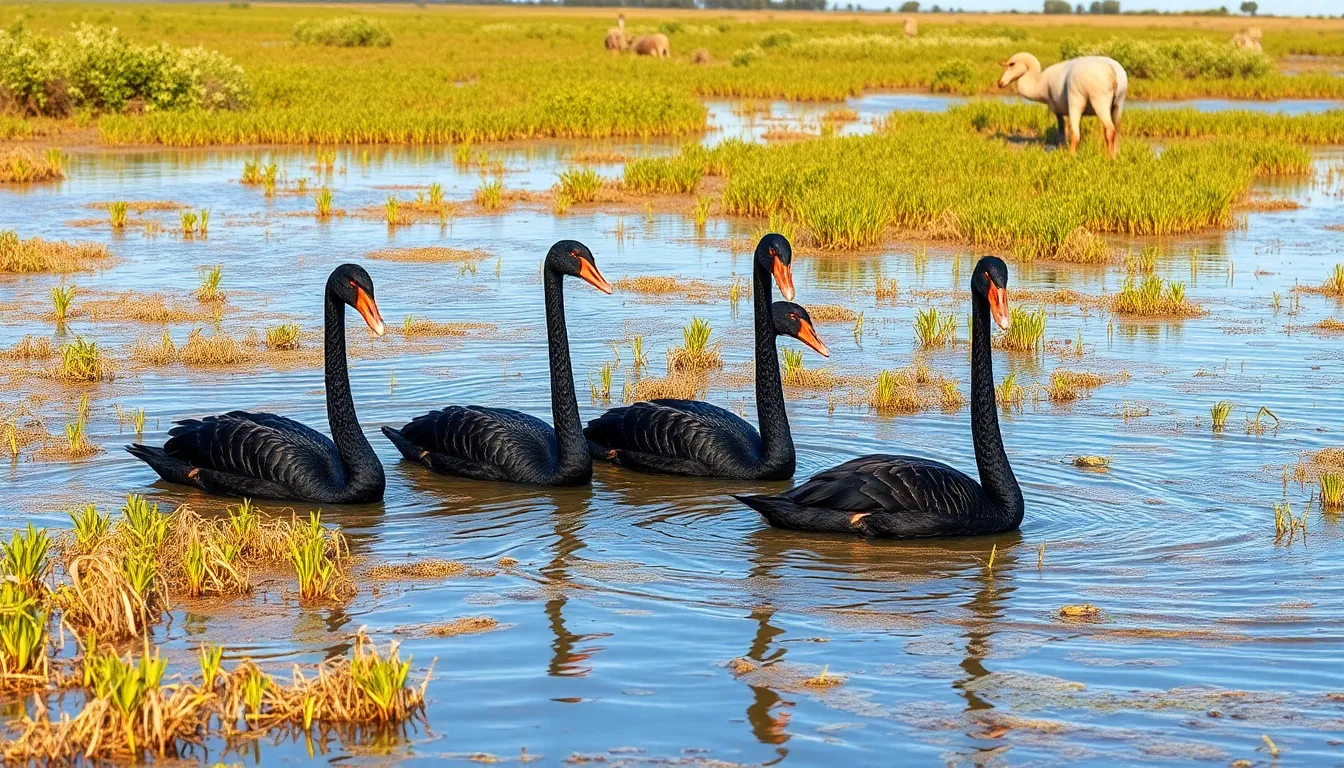
Black swans occupy diverse aquatic environments across their range, adapting to both freshwater and brackish water systems. These magnificent birds demonstrate remarkable flexibility in habitat selection while maintaining exact preferences for shallow wetland areas.
Native Range in Australia
Australia serves as the exclusive native home for black swan populations, with these waterbirds distributed across the continent’s southern and eastern regions. We find the highest concentrations in Western Australia, South Australia, Victoria, Tasmania, and southeastern New South Wales.
The species thrives in permanent wetlands including lakes, rivers, coastal lagoons, and swamplands throughout these territories. Black swans prefer water depths between 0.5 and 2 meters, allowing them to feed effectively by dipping their long necks underwater. Murray River systems, Lake Alexandrina, and the Coorong lagoon complex support some of Australia’s largest breeding colonies.
Seasonal movements occur as black swans follow rainfall patterns and water availability across the continent. During drought periods, populations concentrate in permanent water bodies along the coast and major river systems. Western Australia’s extensive wetland networks host approximately 100,000 black swans during peak seasons, representing nearly one-third of the continent’s total population.
Introduced Populations Worldwide
New Zealand became the first successful introduction site for black swan populations during the 1860s, when European settlers released breeding pairs into Canterbury and Otago regions. These introduced birds established thriving colonies that now number over 60,000 individuals across both North and South Islands.
European introductions began in the early 1900s, with established populations currently residing in the United Kingdom, Netherlands, and France. Britain’s black swan population centers around ornamental lakes and park systems, though some feral colonies exist in southern England and Scotland. Dutch populations inhabit the Kinderdijk and Biesbosch wetland areas, while French birds concentrate in the Loire Valley region.
Japan hosts introduced black swan populations in Hokkaido Prefecture, where approximately 200 birds inhabit lake systems around Kushiro and Akan National Parks. These Asian populations represent the northernmost established colonies outside Australia, demonstrating the species’ adaptability to temperate climates.
| Region | Population Size | Primary Habitat Types |
|---|---|---|
| Australia | 500,000+ | Natural wetlands, coastal lagoons |
| New Zealand | 60,000+ | Lakes, rivers, coastal areas |
| United Kingdom | 2,000+ | Ornamental lakes, parklands |
| Netherlands | 800+ | Wetland reserves, canals |
| France | 500+ | River valleys, managed wetlands |
| Japan | 200+ | Mountain lakes, marshlands |
Behavior and Social Structure
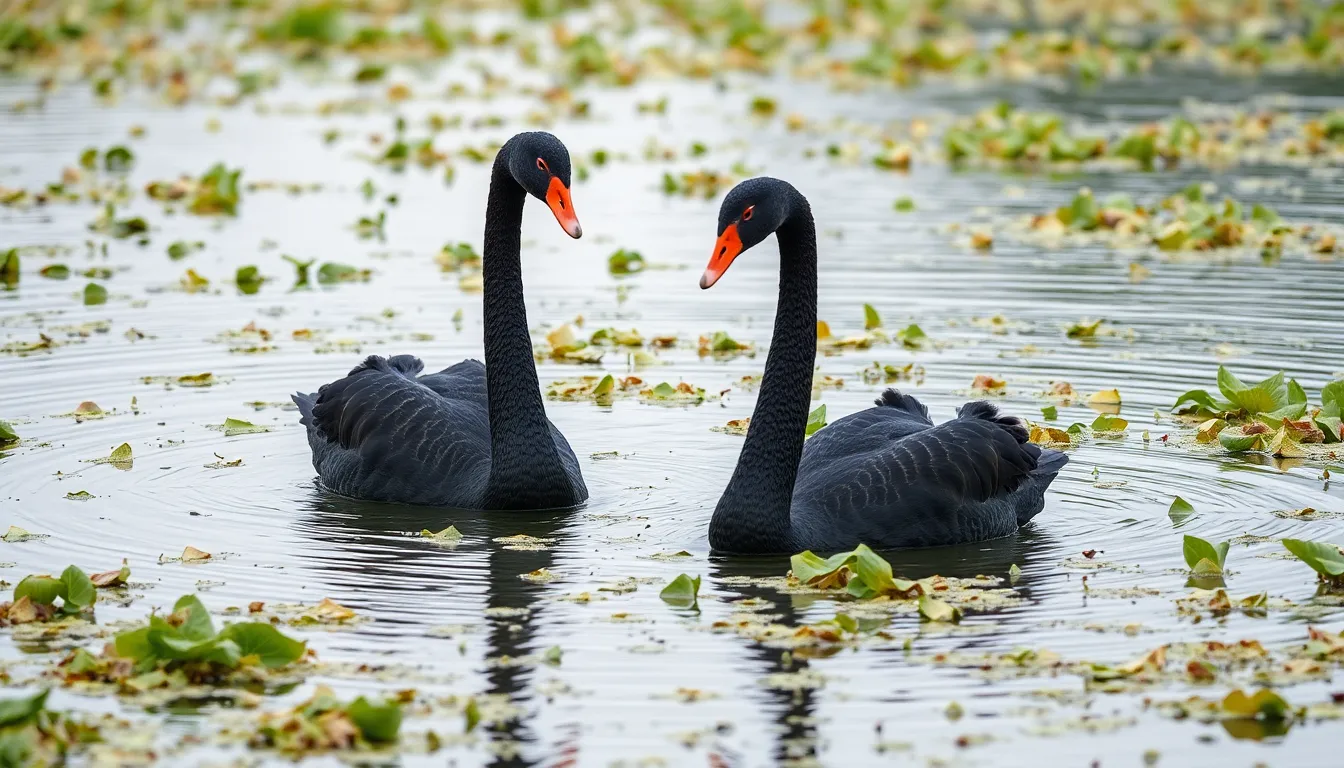
Black swan behavior reflects complex social dynamics that distinguish these birds from their white counterparts. We observe sophisticated group formations and feeding strategies that demonstrate remarkable adaptability across diverse wetland environments.
Feeding Habits and Diet
Black swans exhibit predominantly herbivorous feeding patterns that center on aquatic vegetation consumption. We find these birds utilizing their elongated necks to reach submerged plants at depths extending 1 meter below the surface. Their primary diet consists of algae, pondweed, sedges, and aquatic grasses that flourish in shallow wetland areas.
Feeding behaviors occur both during daylight hours and at dawn or dusk when vegetation becomes more accessible. We document grazing activities on terrestrial grasses adjacent to water bodies, particularly during drought conditions when aquatic plants become scarce. Supplemental protein sources include small invertebrates, aquatic insects, and mollusks that attach to plant matter during foraging.
Filter feeding mechanisms allow black swans to process large volumes of water through specialized bill structures. We observe coordinated group feeding where flocks move systematically across wetland areas, creating feeding territories that maximize resource utilization. Individual birds consume approximately 1.5 kilograms of vegetation daily, with feeding sessions lasting 4-6 hours across multiple periods.
Mating Rituals and Breeding Patterns
Black swan mating displays feature elaborate courtship ceremonies that strengthen pair bonds throughout breeding seasons. We witness synchronized swimming patterns where pairs perform coordinated movements including head bobbing, wing lifting, and neck intertwining that can continue for 30-45 minutes.
Breeding territories establish around permanent water sources with pairs defending areas spanning 2-3 hectares during nesting periods. We document monogamous pair bonds that typically last multiple breeding seasons, though some individuals form new partnerships when mates become unavailable. Nest construction involves both partners gathering vegetation to create platforms measuring 1.5 meters in diameter.
Egg laying occurs between May and September in Australia, with clutches containing 4-8 large greenish-white eggs. We record incubation periods lasting 35-40 days with both parents alternating brooding responsibilities. Cygnets remain dependent on parents for 5-6 months, learning essential foraging techniques and social behaviors through observation and practice.
Colony breeding behaviors emerge when multiple pairs nest in proximity, creating protective communities that enhance chick survival rates. We observe cooperative brood care where non-breeding adults assist with territory defense and predator deterrence, demonstrating complex social structures that extend beyond immediate family units.
Black Swan Bird vs Other Swan Species
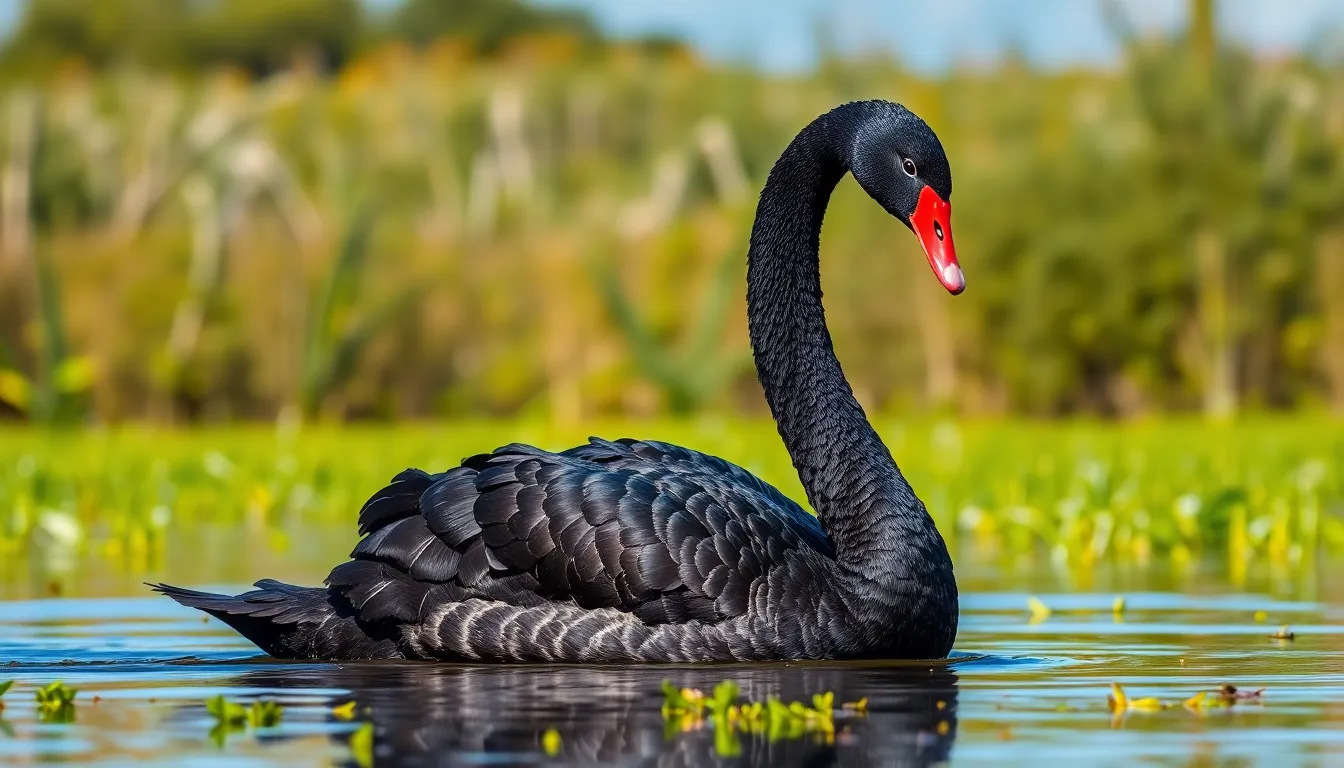
Black swans demonstrate remarkable differences from their northern hemisphere counterparts that extend far beyond their distinctive coloring. These variations cover physical characteristics, behavioral patterns, and ecological adaptations that make black swans uniquely suited to Australian environments.
Key Differences from White Swans
Black swans exhibit several distinctive features that separate them from mute swans, trumpeter swans, and other white species. Their jet-black plumage creates the most obvious visual contrast, while their bright orange-red bills with white tips differ significantly from the orange bills of mute swans or the solid black bills of trumpeter swans.
Size comparisons reveal that black swans measure 110-142 cm in length compared to mute swans at 125-170 cm, though both species maintain similar wingspans of approximately 160-200 cm. Weight distributions show black swans averaging 4-8.5 kg, positioning them between the lighter whooper swans (7.4-14 kg) and smaller tundra swans (3.4-9.6 kg).
Neck length proportions distinguish black swans with their notably longer necks relative to body size, containing 23 cervical vertebrae compared to the 20-25 found in northern swan species. Flight patterns also differ as black swans demonstrate more agile aerial maneuvers and shorter takeoff distances than their bulkier white relatives.
Vocalization patterns create another key distinction, with black swans producing softer musical notes and trumpeting calls rather than the hissing sounds characteristic of mute swans or the loud bugling of trumpeter swans.
Unique Traits and Adaptations
Black swans possess specialized feeding adaptations that enable them to thrive in shallow Australian wetlands. Their longer necks allow diving depths of up to 1 meter, exceeding the typical 0.5-0.6 meter reach of northern swan species when accessing submerged vegetation.
Curly tertial feathers create the distinctive “bustle” appearance unique to black swans, serving both display purposes and thermoregulation in variable Australian climates. These ornamental feathers molt annually and grow back more elaborate with age, distinguishing mature breeding adults.
Social structure adaptations include flexible flock formations that can exceed 50,000 individuals during molting seasons, far surpassing the typical family group sizes of 4-8 birds observed in northern swan species. Cooperative breeding behaviors emerge during nesting periods, with non-breeding pairs often assisting territorial pairs in territory defense and predator deterrence.
Drought adaptation mechanisms enable black swans to survive extended dry periods by concentrating in permanent water bodies and adjusting their breeding cycles according to rainfall patterns. This flexibility contrasts with northern swans that follow more rigid seasonal migration schedules.
Temperature tolerance ranges allow black swans to function effectively in climates reaching 45°C, while northern species typically require cooler environments below 25°C for optimal comfort. Heat dissipation strategies include wing spreading behaviors and seeking shade during peak temperatures.
Conservation Status and Population Trends
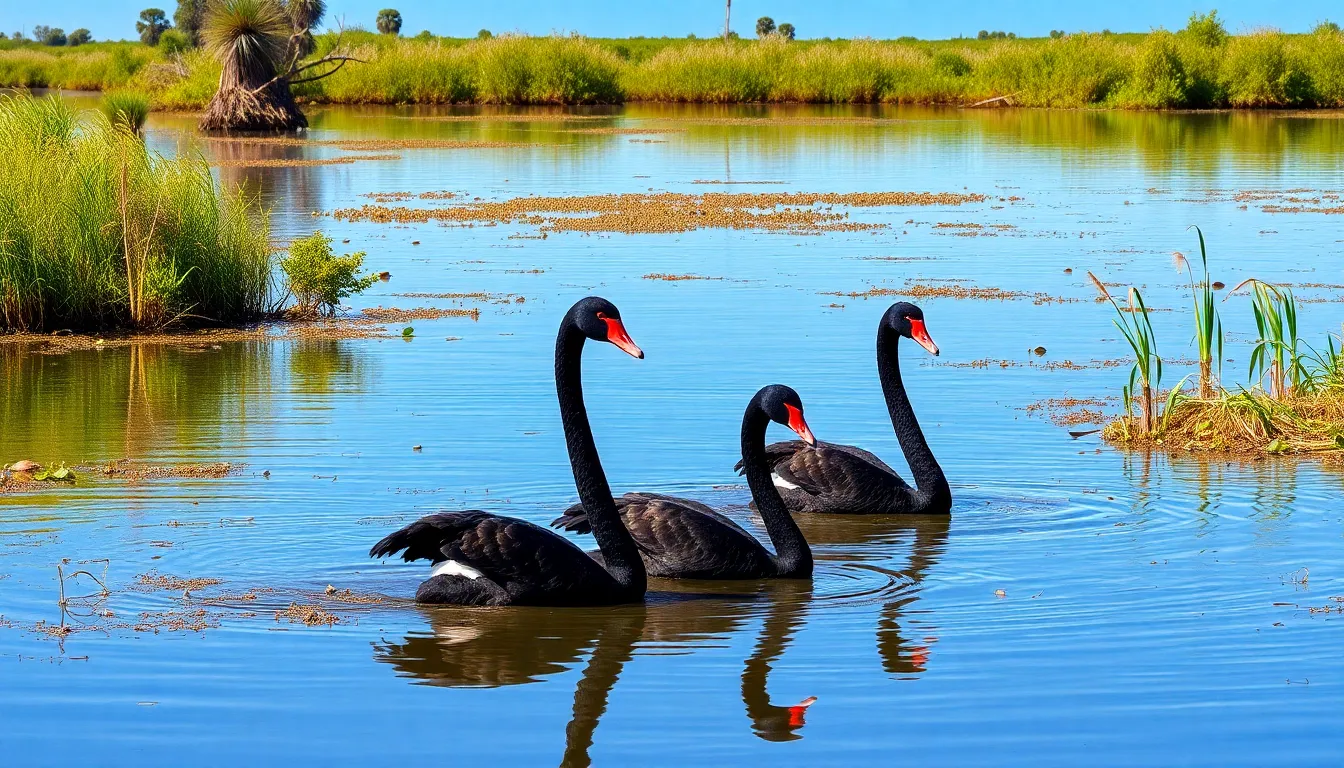
Black swan bird populations maintain stable numbers across their native Australian range, with current estimates indicating approximately 500,000 to 1 million individuals continent-wide. The International Union for Conservation of Nature (IUCN) classifies Cygnus atratus as a species of “Least Concern” due to their robust population stability and widespread distribution.
Population monitoring reveals consistent growth patterns in southeastern Australia, where favorable wetland conditions support breeding colonies exceeding 10,000 pairs annually. Western Australia hosts the largest concentrations, particularly around Perth’s metropolitan wetlands where urban development creates permanent water sources that benefit nesting black swans.
Climate variability influences population distribution across different regions, with drought periods causing temporary relocations to permanent water bodies. During El Niño events, we observe population shifts from inland wetlands to coastal areas where water availability remains consistent throughout breeding seasons.
Regional Population Data:
| Region | Estimated Population | Trend Status | Primary Habitat |
|---|---|---|---|
| Western Australia | 200,000-400,000 | Stable | Coastal wetlands |
| Victoria/Tasmania | 150,000-250,000 | Increasing | Inland lakes |
| New South Wales | 100,000-200,000 | Stable | River systems |
| Queensland | 50,000-100,000 | Fluctuating | Seasonal wetlands |
Introduced populations demonstrate varying success rates across different continents, with New Zealand supporting approximately 60,000 black swans that continue expanding their range throughout both North and South Islands. European populations remain smaller but stable, with the Netherlands maintaining around 3,000 individuals and the United Kingdom hosting roughly 1,500 breeding pairs.
Habitat modification presents the primary conservation challenge, as urban development reduces available wetland areas essential for black swan bird reproduction and feeding. Wetland restoration programs across Australia focus on maintaining shallow water environments that support the specialized feeding behaviors these birds require.
Agricultural practices create both opportunities and challenges for population management, with rice farming providing temporary habitat while intensive grazing reduces native vegetation around natural wetlands. Water allocation policies increasingly recognize black swan habitat requirements when managing river systems and artificial water bodies.
Human interaction influences population dynamics in urban environments, where supplemental feeding programs sometimes create unnaturally dense concentrations that stress local ecosystems. Management strategies emphasize maintaining natural foraging behaviors while protecting established breeding territories from recreational disturbance.
Research initiatives track long-term population trends through satellite monitoring and citizen science programs, enabling conservation biologists to identify critical habitat areas requiring protection measures. These monitoring efforts reveal migration patterns that inform water management decisions affecting black swan bird populations across multiple states.
Genetic diversity studies indicate healthy population structures with sufficient gene flow between regional groups, suggesting current conservation approaches adequately maintain species viability across their extensive range.
Cultural Significance and Symbolism
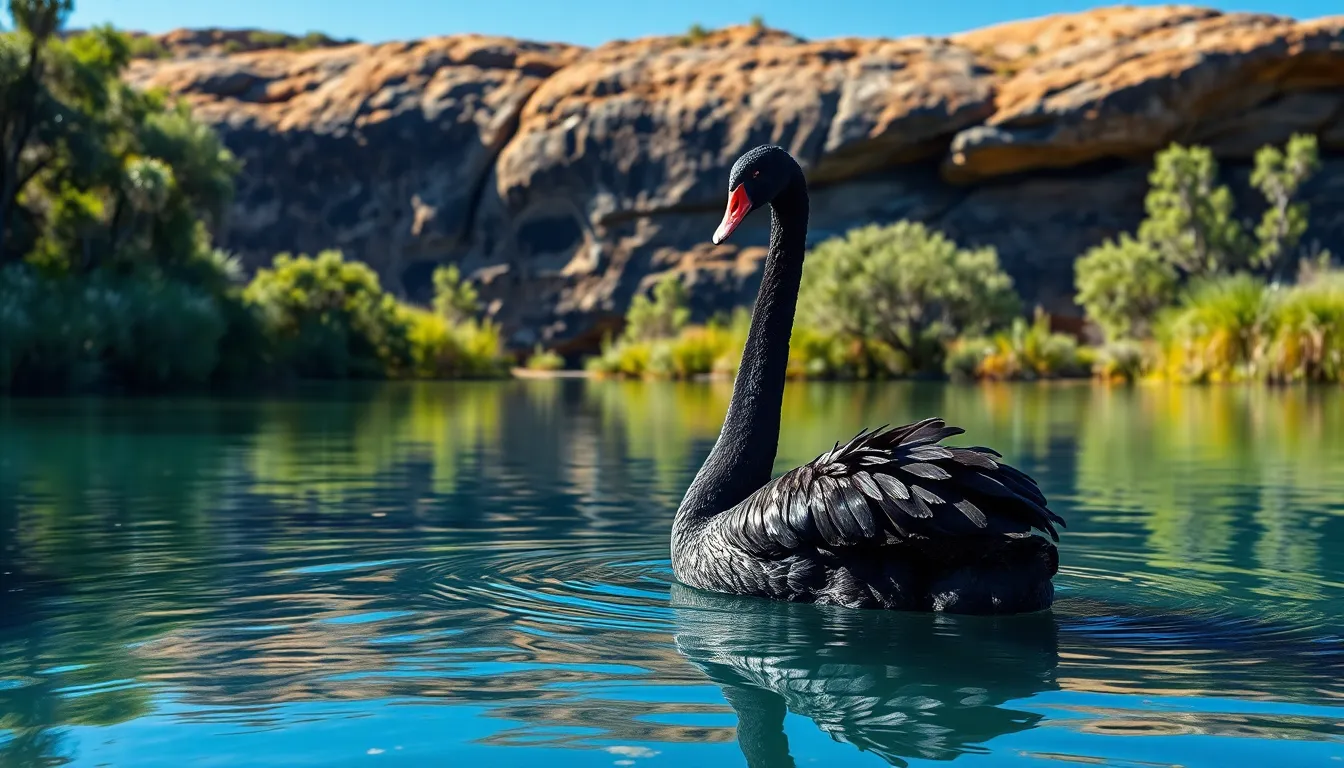
Black swan bird symbolism transcends its physical presence to embody profound cultural meanings across diverse societies. These magnificent waterfowl represent transformation, rarity, and the unexpected in human consciousness.
Aboriginal Australian Connections
Aboriginal Australian cultures have revered black swans for over 40,000 years through dreamtime stories and spiritual practices. The Noongar people of southwestern Australia consider black swans sacred ancestors that created waterways during their eternal journeys across the industry. Traditional stories describe how black swans taught early peoples about seasonal changes and water sources, establishing deep ecological knowledge systems.
Several Aboriginal groups incorporate black swan totems into their clan structures and ceremonial practices. The Wurundjeri people of Victoria regard black swans as symbols of family unity and cooperative living, reflecting the birds’ strong pair bonds and communal nesting behaviors. Rock art sites throughout Australia feature black swan depictions dating back thousands of years, with notable examples found in Kakadu National Park and the Grampians region.
Contemporary Aboriginal communities continue honoring black swans through art, dance, and storytelling traditions. Artists from the Tiwi Islands create distinctive black swan sculptures and paintings that celebrate the connection between water, land, and spiritual identity. These cultural practices preserve ancient wisdom while adapting to modern contexts, demonstrating the enduring significance of black swans in Aboriginal Australian heritage.
Modern Cultural References
European literature transformed black swans from biological curiosities into powerful metaphors for the impossible becoming reality. The phrase “black swan event” emerged from this cultural shift, representing highly improbable occurrences with massive impact on human society. Nassim Nicholas Taleb popularized this concept in his 2007 book, applying black swan theory to financial markets, technological breakthroughs, and historical events.
Ballet embraces black swan symbolism through performances like “Swan Lake,” where the black swan character represents deception, passion, and forbidden desires contrasting with white swan purity. Modern interpretations explore psychological themes of duality and transformation, with the 2010 film “Black Swan” showcasing these complex symbolic layers through its protagonist’s journey.
Contemporary artists and designers frequently incorporate black swan imagery to represent elegance, mystery, and unexpected beauty. Fashion brands use black swan motifs to convey sophistication and rarity, while architects draw inspiration from their graceful forms in building designs. Social media platforms feature black swan photography and art, generating millions of engagement interactions annually and reinforcing their status as cultural icons.
Financial institutions and business strategists regularly reference black swan events when discussing risk management and market volatility. The 2008 financial crisis, COVID-19 pandemic, and technological disruptions exemplify modern black swan occurrences that reshape global economies and social structures.
Caring for Black Swan Birds in Captivity
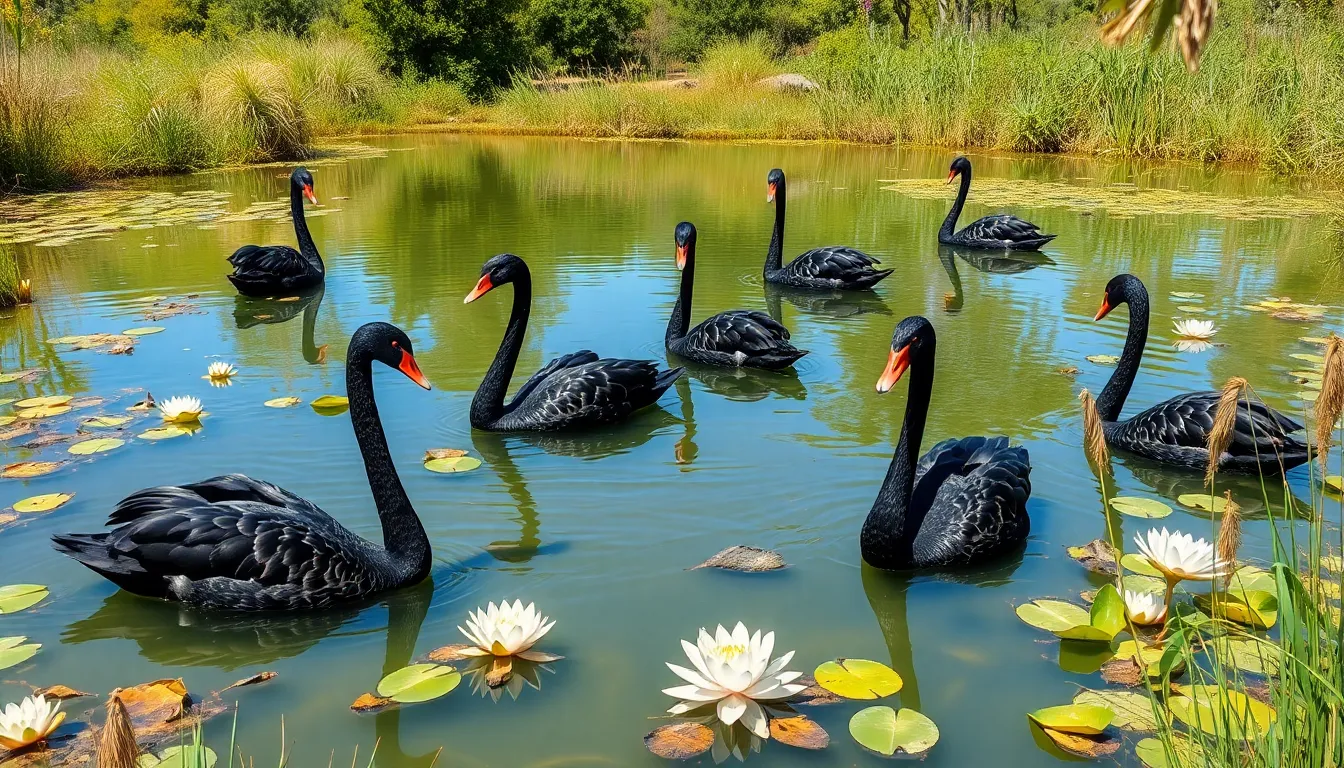
Caring for black swan birds in captivity requires specialized knowledge of their complex environmental and dietary requirements. These magnificent waterfowl demand exact conditions that replicate their natural Australian wetland habitats while accommodating their unique social behaviors and physical characteristics.
Housing Requirements
Housing black swan birds demands extensive water features with minimum dimensions of 30 feet by 40 feet for breeding pairs. We recommend water depths between 3 to 6 feet to accommodate their natural feeding behaviors and swimming patterns. Ponds must include shallow areas measuring 1 to 2 feet deep where black swans can comfortably wade and filter feed.
Enclosure size calculations indicate 2,000 square feet minimum per breeding pair, with additional 500 square feet allocated for each juvenile bird. Fencing heights reach 6 feet with mesh spacing no larger than 2 inches to prevent escapes and protect against predators. Wire mesh extends 18 inches underground to deter digging predators such as foxes and raccoons.
Temperature control systems maintain water temperatures between 50°F and 75°F throughout winter months. Heating elements prevent complete freezing while circulation pumps maintain water quality and oxygen levels. Filtration systems process 100% of pond volume every 4 hours to remove waste products and maintain clarity.
Nesting platforms constructed from natural materials like reeds and grasses provide breeding sites elevated 6 to 12 inches above water level. Platform dimensions measure 4 feet by 4 feet with surrounding vegetation offering privacy and security. Multiple platforms accommodate territorial behaviors and reduce conflicts between breeding pairs.
Nutritional Needs
Nutritional requirements for captive black swans center on aquatic vegetation comprising 85% of their total diet. We provide submerged plants including pondweed, watermilfoil, and algae species that replicate their natural foraging environment. Daily vegetation intake ranges from 8 to 12 pounds per adult bird depending on seasonal activity levels.
Supplemental feeding includes commercial waterfowl pellets containing 16% protein content during breeding seasons and 14% protein during maintenance periods. Pellet quantities measure 1 to 2 cups per adult bird distributed across morning and evening feeding sessions. Fresh vegetables such as lettuce, spinach, and aquatic plants supplement pellet nutrition.
Calcium supplementation becomes critical during egg production periods from May through September. We offer crushed oyster shells and calcium carbonate supplements measuring 2 tablespoons per breeding female daily. Vitamin E supplements at 50 IU per bird support reproductive health and immune system function.
Water quality monitoring ensures pH levels between 6.5 and 8.5 while maintaining dissolved oxygen above 5 parts per million. Nitrate concentrations remain below 40 parts per million through regular water changes and biological filtration. Testing occurs weekly during breeding seasons and monthly during maintenance periods.
Feeding schedules accommodate natural foraging patterns with 60% of daily nutrition provided during early morning hours. Evening supplements comprise remaining 40% of nutritional requirements while allowing continuous access to aquatic vegetation. Seasonal adjustments increase protein content by 20% during molting periods and breeding cycles.
Best Places to Observe Black Swan Birds in the Wild
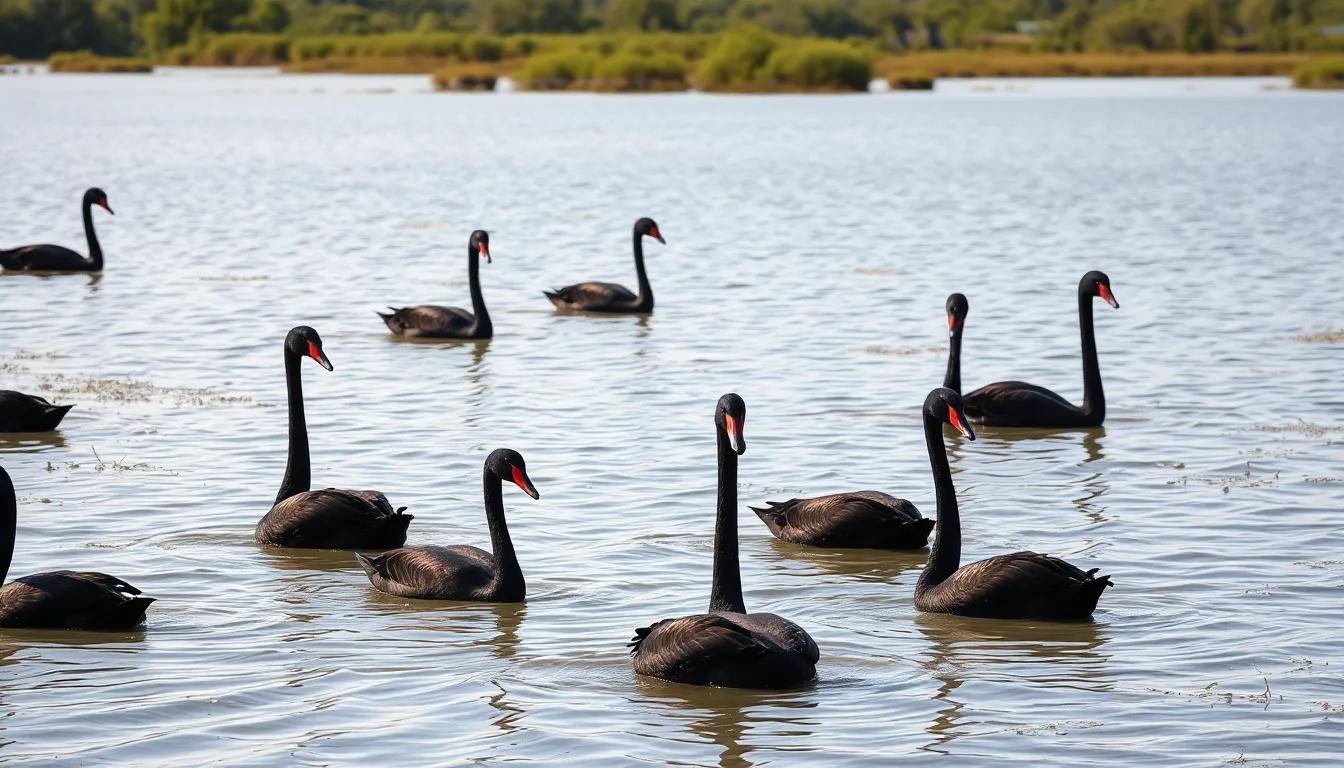
Australia’s diverse wetland systems provide exceptional opportunities to witness black swans in their natural habitat. We’ve identified the most reliable locations across different states where wildlife enthusiasts can observe these magnificent birds throughout the year.
Western Australia’s Premier Black Swan Destinations
Perth’s Swan River stands out as the most accessible location for black swan observation, with populations exceeding 3,000 individuals during peak seasons. Black swans congregate near Kings Park and South Perth foreshore areas, particularly between April and October when water levels remain optimal.
Lake Monger in Perth maintains year-round populations of 200-400 black swans, offering consistent viewing opportunities for photographers and researchers. The lake’s shallow depths and abundant aquatic vegetation create ideal feeding conditions that attract large flocks throughout breeding seasons.
Rottnest Island’s inland lakes support seasonal populations of black swans, with Thomson Bay and Government House Lake providing sheltered viewing areas. Wildlife observers record the highest concentrations between May and September when breeding activities peak across the island’s freshwater systems.
Victoria’s Key Black Swan Habitats
Lake Wendouree in Ballarat hosts one of Victoria’s largest stable black swan populations, with numbers ranging from 800 to 1,200 individuals depending on seasonal conditions. The lake’s urban setting provides excellent accessibility while maintaining natural feeding environments that support consistent bird populations.
Western Treatment Plant near Melbourne attracts massive black swan congregations during molting seasons, with recorded numbers exceeding 5,000 birds in peak periods. Access requires permits through Melbourne Water, but the site offers unparalleled opportunities to observe large scale social behaviors and feeding patterns.
Port Phillip Bay’s shallow coastal areas support scattered populations throughout the year, with Altona and Werribee sections providing the most reliable viewing locations. Black swans use these saltwater environments particularly during drought periods when freshwater sources become limited.
South Australia’s Notable Observation Sites
Coorong National Park encompasses Australia’s most important black swan habitat, supporting populations that fluctuate between 10,000 and 50,000 individuals based on water levels and seasonal conditions. The park’s extensive lagoon system provides diverse viewing opportunities across 140 kilometers of protected waterways.
Adelaide’s River Torrens maintains urban black swan populations that remain visible year-round near the city center and university areas. Population sizes typically range from 100 to 300 birds, with peak numbers occurring during winter months when regional drought conditions drive migrations.
Murray River wetlands support substantial black swan populations across multiple sites, with Chowilla Regional Reserve and Banrock Station providing structured observation facilities. These locations record consistent populations of 500-2,000 individuals throughout most seasons.
New South Wales and Queensland Locations
Centennial Park lakes in Sydney offer urban black swan viewing with populations maintained between 50 and 150 individuals throughout the year. The controlled environment provides excellent photography opportunities while supporting natural behaviors including breeding and territorial displays.
Lake Jindabyne attracts seasonal black swan populations during warmer months, with numbers varying from 200 to 800 individuals based on water levels and food availability. The alpine location provides unique viewing experiences as black swans adapt to higher altitude conditions.
Queensland’s coastal lagoons support smaller but consistent black swan populations, with Currumbin Creek and Tallebudgera Creek offering reliable viewing opportunities. These subtropical environments demonstrate black swan adaptability across diverse climate zones throughout their range.
International Black Swan Observation Sites
New Zealand’s Lake Ellesmere supports the largest introduced black swan population outside Australia, with numbers estimated between 40,000 and 60,000 individuals. Christchurch’s Avon River and Hagley Park provide accessible urban viewing locations with stable year-round populations.
United Kingdom’s established populations concentrate in ornamental lakes and country estates, with Dawlish Water Park in Devon and several locations across the Norfolk Broads offering consistent observation opportunities. These populations typically maintain 20-100 individuals per site.
Netherlands’ black swan populations inhabit urban parks and nature reserves, particularly around Amsterdam and Utrecht where breeding pairs establish territories in protected wetland areas. Population sizes remain modest but provide unique European viewing experiences for black swan enthusiasts.
Conclusion
The black swan stands as one of nature’s most captivating contradictions – a bird that challenged centuries of assumptions while embodying grace and resilience. Through our exploration we’ve discovered that these remarkable creatures represent far more than their striking appearance suggests.
From their complex social behaviors to their cultural significance across different societies black swans continue to fascinate scientists and wildlife enthusiasts alike. Their successful adaptation to diverse environments worldwide demonstrates nature’s incredible flexibility and the species’ remarkable evolutionary advantages.
Whether you’re planning to observe them in Australia’s pristine wetlands or simply appreciating their symbolic meaning in modern culture black swans remind us that the unexpected often brings the most profound discoveries. Their story encourages us to remain open to possibilities that challenge our preconceived notions about the natural industry.
Frequently Asked Questions
What is a black swan bird?
A black swan (Cygnus atratus) is an iconic Australian waterfowl species with predominantly jet-black plumage, bright orange-red bill, and elegant curly tertial feathers. They are among the largest swan species globally and the heaviest flying birds in their habitat, with males typically outweighing females. First discovered by Europeans in 1697, they challenged expectations about swan coloration.
Where do black swans naturally live?
Black swans are native to Australia, primarily inhabiting southern and eastern regions. They thrive in diverse aquatic environments including permanent wetlands, lakes, rivers, and coastal lagoons, preferring shallow waters. They follow seasonal rainfall patterns, concentrating in permanent water bodies during droughts and moving to temporary wetlands when conditions improve.
What do black swans eat?
Black swans are predominantly herbivorous, feeding mainly on aquatic vegetation. They use filter feeding techniques and engage in coordinated group foraging strategies. Their specialized feeding adaptations allow them to thrive in shallow wetlands, consuming submerged plants, algae, and occasionally small aquatic invertebrates found among vegetation.
How do black swans breed?
Black swans breed from May to September, engaging in elaborate mating rituals including synchronized swimming displays. Both parents share incubation duties and cooperative brood care. They establish territories during breeding season, with pairs working together to raise cygnets. Their social structures extend beyond immediate family units, often involving complex group dynamics.
Are black swans endangered?
Black swans are classified as “Least Concern” by the IUCN, with stable populations ranging from 500,000 to 1 million individuals across Australia. Population monitoring shows growth in southeastern Australia, particularly in areas with favorable wetland conditions. Their conservation status remains secure despite challenges from habitat modification and urban development.
Can black swans be kept in captivity?
Yes, but black swans require specialized care including extensive water features, specific enclosure sizes, and temperature control systems. They need aquatic vegetation in their diet and supplemental feeding during breeding seasons. Proper water quality monitoring and feeding schedules that mimic natural foraging patterns are essential for their health and well-being.
Where can I see black swans in the wild?
The best places to observe black swans include Australia’s wetland systems, particularly Perth’s Swan River and Lake Monger in Western Australia. Key viewing locations also exist in Victoria, South Australia, New South Wales, and Queensland. International populations can be observed in New Zealand and the United Kingdom.
How are black swans different from white swans?
Black swans have longer necks, softer vocalizations, and more agile flight patterns compared to northern hemisphere white swans. They exhibit different social structures that can accommodate larger flock sizes during molting seasons. Their specialized adaptations help them thrive in shallow wetlands and adapt to drought conditions more effectively.
What is the cultural significance of black swans?
Black swans symbolize transformation, rarity, and the unexpected across various cultures. Aboriginal Australians view them as sacred ancestors, incorporating them into ecological knowledge and ceremonial practices. In modern culture, they’ve become metaphors in literature, finance, and art, representing elegance while serving as references for discussing risk management and market volatility.

